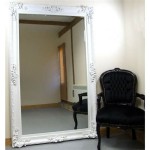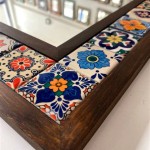Baroque Style Mirrors: A Reflection of Opulence and Artistry
Baroque style mirrors represent a significant facet of interior design history, embodying the grandeur, drama, and ornamentation characteristic of the Baroque period. Originating in Italy during the early 17th century, the Baroque aesthetic quickly spread across Europe, influencing art, architecture, and decorative arts. Mirrors, previously simple functional objects, were elevated to elaborate works of art that served not only to reflect images but also to symbolize wealth, status, and refined taste.
The Baroque era was a time of significant change, both politically and socially. The Catholic Church sought to reassert its authority following the Protestant Reformation, and art became a powerful tool for conveying religious messages and reinforcing the power of the monarchy. Baroque art, therefore, embraced theatricality, dynamism, and emotional intensity. These characteristics are evident in the elaborate designs, bold curves, and luxurious materials used in Baroque style mirrors.
The influence of the Palace of Versailles, with its Hall of Mirrors, cannot be overstated. This iconic space, designed by Jules Hardouin-Mansart, showcased the unparalleled craftsmanship and opulence of the French court. The Hall of Mirrors became a symbol of royal power and served as an inspiration for Baroque style mirrors throughout Europe. Aristocrats and wealthy merchants sought to emulate the grandeur of Versailles in their own homes, commissioning elaborate mirrors that reflected their social standing.
The production of Baroque mirrors involved a complex process, requiring the expertise of skilled artisans. Glassmaking techniques advanced during this period, allowing for the creation of larger and clearer mirrors. However, the process remained labor-intensive, contributing to the high cost and exclusivity of these objects. The mirror frames themselves were crafted from a variety of materials, including wood, gesso, and precious metals. Gilding, the application of thin layers of gold leaf, was a common technique used to enhance the richness and luminosity of the frames. Carving, often depicting elaborate floral motifs, scrolls, and mythological figures, added depth and complexity to the designs.
Key Characteristics of Baroque Style Mirrors
Baroque mirrors possess several defining characteristics that distinguish them from other styles of mirrors. These characteristics reflect the broader aesthetic principles of the Baroque period, emphasizing drama, ornamentation, and a sense of grandeur.
One of the most prominent features of Baroque mirrors is their elaborate ornamentation. Frames are often adorned with intricate carvings of acanthus leaves, scrolls, shells, and other decorative motifs. These carvings are executed with meticulous detail, showcasing the skill and artistry of the craftsman. The use of gilding further enhances the richness and opulence of the frames, creating a visual spectacle.
Another defining characteristic is the use of bold curves and asymmetrical designs. Baroque mirrors often feature undulating lines, C-scrolls, and S-scrolls, creating a sense of movement and dynamism. Unlike the more symmetrical and restrained designs of earlier periods, Baroque mirrors embrace asymmetry, adding a touch of drama and visual interest. This asymmetry is often subtle, but it contributes to the overall sense of energy and vitality that is characteristic of the Baroque style.
The scale of Baroque mirrors is also noteworthy. These mirrors were often designed to be large and imposing, serving as focal points in grand rooms. Their size not only reflected the wealth and status of the owner but also enhanced the sense of spaciousness and light within the room. A large Baroque mirror could visually double the size of a room, creating a more impressive and opulent atmosphere.
Materials and Techniques Used in Crafting Baroque Mirrors
The creation of Baroque mirrors involved a variety of materials and techniques, each contributing to the overall aesthetic and quality of the finished product. The selection of materials and the mastery of techniques were essential for achieving the desired level of opulence and detail.
Wood was the primary material used for constructing the mirror frames. Various types of wood were employed, including oak, walnut, and pine. The choice of wood depended on its availability, cost, and suitability for carving. Hardwoods like oak and walnut were often preferred for their durability and fine grain, which allowed for intricate carving. Pine, being a softer wood, was sometimes used for less detailed areas of the frame.
Gesso, a mixture of plaster of Paris, glue, and water, was applied to the wood frame to create a smooth and uniform surface. The gesso layer provided a base for gilding or painting. Multiple layers of gesso were typically applied, each sanded smooth to achieve a flawless finish. The quality of the gesso layer was crucial for the final appearance of the mirror, as it directly affected the smoothness and reflectivity of the surface.
Gilding was a common technique used to enhance the richness and luminosity of the mirror frames. Thin sheets of gold leaf were carefully applied to the gessoed surface, creating a brilliant and luxurious effect. The gilding process required skill and precision, as the gold leaf was extremely delicate and easily damaged. The use of gold leaf not only added to the aesthetic appeal of the mirror but also symbolized wealth and status.
Carving played a significant role in the ornamentation of Baroque mirrors. Skilled carvers used specialized tools to create intricate floral motifs, scrolls, and figurative sculptures on the wood frame. The carving process required a deep understanding of anatomy, perspective, and composition. The carvers often drew inspiration from classical mythology, nature, and religious themes. The level of detail and skill displayed in the carving was a testament to the artistry and craftsmanship of the Baroque period.
The Evolution and Regional Variations of Baroque Mirrors
While the Baroque style originated in Italy, it evolved and adapted as it spread across Europe, resulting in distinct regional variations in mirror design. Different countries and regions incorporated their own artistic traditions and preferences, leading to a diverse range of styles within the broader Baroque framework.
Italian Baroque mirrors, particularly those from Venice, were renowned for their elaborate glasswork and intricate detailing. Venetian artisans were masters of glassmaking, producing mirrors with exceptional clarity and brilliance. Venetian mirrors often featured delicate floral decorations, cherubs, and other whimsical motifs. The use of colored glass and mirrored panels added to the overall richness and complexity of the designs.
French Baroque mirrors, influenced by the Palace of Versailles, emphasized grandeur and formality. French mirrors typically featured symmetrical designs, elaborate carvings, and extensive gilding. The frames were often adorned with royal symbols, such as the fleur-de-lis, reflecting the power and authority of the monarchy. The French Baroque style was characterized by its elegance, refinement, and attention to detail.
English Baroque mirrors, while still incorporating elements of the Baroque style, tended to be more restrained and understated than their Italian and French counterparts. English mirrors often featured simpler carvings, darker woods, and less gilding. The focus was on elegance and practicality rather than overt ostentation. English Baroque mirrors were often designed to complement the architectural style of the home, reflecting the English emphasis on harmony and balance.
Spanish Baroque mirrors were characterized by their dramatic ornamentation and use of dark woods. Spanish mirrors often featured elaborate carvings of religious figures, symbols of power, and scenes from Spanish history. The use of wrought iron and other metalwork added to the overall sense of drama and intensity. Spanish Baroque mirrors reflected the country's rich cultural heritage and its strong Catholic traditions.
In conclusion, Baroque style mirrors represent a significant chapter in the history of decorative arts. Their elaborate designs, luxurious materials, and skilled craftsmanship reflect the opulence and grandeur of the Baroque period. From the iconic Hall of Mirrors at Versailles to the diverse regional variations across Europe, Baroque mirrors continue to captivate and inspire, serving as enduring symbols of artistry and refinement.

Beautiful Wall Mirror In Italian Baroque Style Osman Antique

What Is Baroque Style Mirror

Baroque Mirror Vintage Style Oval Frame Gold Hand Victorian Vanity Makeup Antique Leaf

What Is Baroque Style Mirror

Horchow Baroque Style Mirror Google Images Wall Mirrored Furniture

Casa Padrino Baroque Mirror Gold Cream White Handmade Style Wall With Elegant Decorations And Decorative Angel Figures Furniture Noble Magnificent

What Is Baroque Style Mirror

Baroque Style Mirror With Hand Carved Frame Idfdesign

Casa Padrino Baroque Mirror Gold Rectangular Wall With Elegant Decorations Cloakroom Style Furniture

Large Classic Baroque Mirror Antique Gold Leaf Made In Italy Louis Style Italian Golden Victorian Item 8052 G Israel








